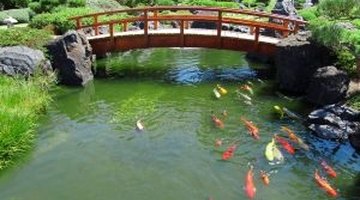How to Connect Garden Ponds
Having two garden ponds in your backyard can make the landscaping beautiful, but connecting them into one continuous watercourse can add to the natural feel. While two established water gardens are harder to connect than brand new ones, it still can be done with only moderate planning and effort.

-
Determine the slope of ground between the two ponds you wish to connect. The water should flow from the higher one to the lower one. If they are even, decide which way you want the water to flow. For ponds that are very close together, water flow will be natural and can go any way it wants.
-
Siphon off some of the water in each established pond using a garden hose or wet-dry vacuum. Use a shovel to dig the trench or waterway between the two ponds as desired. Remove all rocks and roots. Make it at least 2 feet wide for a more natural look. For ponds that are adjacent to each other, no digging is needed.
-
Cut rigid pond liner in the two ponds down to the depth of the trench you dug. If the ponds have flexible liners, dig out the supporting dirt underneath and press the flexible liners downward into the trench. Lay the new piece of flexible liner in the watercourse trench you dug, overlapping the pond liner of the established pond on each side. Hold the sides of it in place with rocks.
-
Apply sealant or adhesive to the underside of the new liner once you have trimmed off any excess. Press it firmly to the pond liner in the two existing ponds to form a water-tight seal. The liner must give continuous coverage between the connecting waterway and the pond. For adjacent ponds, use the flexible liner to create a watertight seal over the edges of both ponds' liners. The water will flow naturally between them as if it was one large pond.
-
Position the new, stronger pond pump in or next to the top pond and run the hose for it down the bottom of the watercourse and into the bottom pond. You also can run it outside the stream bed, or even bury it under the connection path, but that makes it more difficult to fix it later on if there is a problem. It can be hidden by flat stones if desired.
-
Add more water to the newly connected garden ponds and watercourse and turn on the pump. The water will be drawn from the bottom pond to the top pond through the hose and then will trickle and run down the new stream to the lower pond. Complete the pond connection by placing rocks along the edges of the liners and planting some attractive plants nearby.
References
Tips
- For a sloping yard, consider a series of rocky waterfalls in the man-made stream.
Photo Credits
- Belofthe / SXC.hu
More Articles



